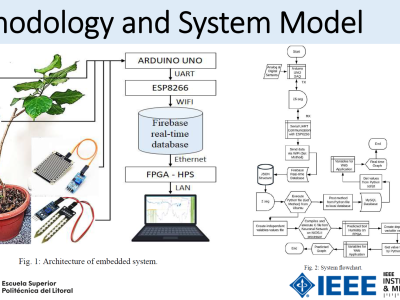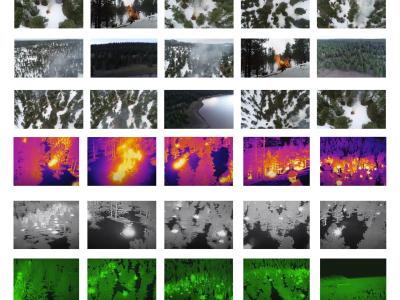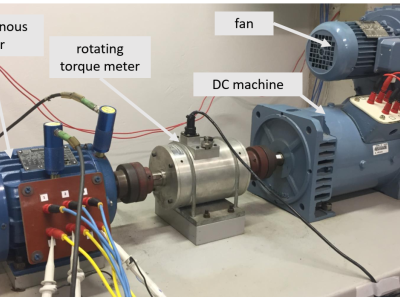Multi-target position servo control of hydractive suspension based on extended state observer

- Citation Author(s):
-
zheng tian
- Submitted by:
- wang bo
- Last updated:
- DOI:
- 10.21227/cvcy-sz60
 120 views
120 views
- Categories:
- Keywords:
Abstract
In this paper, a sliding mode adaptive control strategy is proposed to improve driving comfort effectivelyunder the conditions of ensuring driving safety and limited suspension travel.Considering the non-linear characteristics of the asymmetric single-rod hydraulic actuator with a small occupied volume, the uncertainty of the parameters of the body mass, the friction of the suspension components and the unmodeled dynamics of the system, a half-vehicle active suspension model wasestablished. The adaptive law is designed to combine sliding mode and adaptive algorithms. The sliding mode switching control is selected according to the optimized constant velocity approach law to suppress external uncertainties. The adaptive law estimates the uncertain parameters of the vehicle body. Considering that some state quantities required by the controller are not available, an extended state observer is designed to approximate the wheel's vertical movement speed and the pressure of the rod cavity and non-rod cavity, making the control strategy in this paper more suitable for practical applications. The simulation results show that the control strategy can greatly improve the ride comfort under the premise of ensuring the driving safety and operation stability. The designed sliding mode adaptive controller has a good inhibition effect on the nonlinear disturbance signals with different external amplitudes. When the system has large external disturbance signals, the control strategy in this paper is superior to the traditional backstepping adaptive control strategy
Instructions:
|
AUTOMOTIVE suspension is a collective term for all force-transmitting devices between the body and wheels, and is an important prerequisite to ensure safe driving and stable handling. Suspension can be divided into passive suspension, semi-active suspension and active suspension. Passive suspension is composed of springs and dampers to improve ride comfort and handling stability. However, because these two indicators contradict each other and the passive suspension cannot adjust its structure, the passive suspension is very restricted in improving vehicle performance. Semi-active suspensions can usually adjust their stiffness or damping without external energy injection, and their performance is greatly improved compared to passive suspensions. However, semi-active suspensions still have significant limitations when facing complex road conditions REF _Ref12100 \h [1 08D0C9EA79F9BACE118C8200AA004BA90B02000000080000000A0000005F00520065006600310032003100300030000000 ]- REF _Ref12231 \h [3 08D0C9EA79F9BACE118C8200AA004BA90B02000000080000000A0000005F00520065006600310032003200330031000000 ]. Active suspension has great potential in improving driving safety and comfort, and has attracted more and more attention in recent years REF _Ref12280 \h [4 08D0C9EA79F9BACE118C8200AA004BA90B02000000080000000A0000005F00520065006600310032003200380030000000 ]- REF _Ref12345 \h [6 08D0C9EA79F9BACE118C8200AA004BA90B02000000080000000A0000005F00520065006600310032003300340035000000 ].
It should be noted that the suspension in practice is a very complicated nonlinear coupling system REF _Ref12384 \h [7 08D0C9EA79F9BACE118C8200AA004BA90B02000000080000000A0000005F00520065006600310032003300380034000000 ], and all aspects should be taken into account when designing the controller. First of all, there are parameter uncertainties in the suspension system REF _Ref12482 \h [8 08D0C9EA79F9BACE118C8200AA004BA90B02000000080000000A0000005F00520065006600310032003400380032000000 ]- REF _Ref12522 \h [9 08D0C9EA79F9BACE118C8200AA004BA90B02000000080000000A0000005F00520065006600310032003500320032000000 ]. For example, due to changes in passenger or load, the body mass will fluctuate in a certain range, suspension components have friction and the model established will have some errors with the actual system REF _Ref12571 \h [10 08D0C9EA79F9BACE118C8200AA004BA90B02000000080000000A0000005F00520065006600310032003500370031000000 ]; Secondly, the active suspension requires the corresponding actuator to provide active force, and the actuator usually displays a strong non-linear characteristic REF _Ref12607 \h [11 08D0C9EA79F9BACE118C8200AA004BA90B02000000080000000A0000005F00520065006600310032003600300037000000 ]- REF _Ref12639 \h [13 08D0C9EA79F9BACE118C8200AA004BA90B02000000080000000A0000005F00520065006600310032003600330039000000 ]; Finally, some state variables needed to design the controller are often not easy to obtain REF _Ref12672 \h [14 08D0C9EA79F9BACE118C8200AA004BA90B02000000080000000A0000005F00520065006600310032003600370032000000 ], And the controller should pay attention to ensure driving safety and suspension stroke within the requirements of mechanical structure when improving driving smoothness. This shows that the controller design for the suspension system is a complex multi-objective control problem, and researchers usually do not consider it comprehensively when analyzing the suspension system.
In the existing research, Weichao Sun considered suspension friction and unmodeled dynamics, and designed an anti-saturation adaptive robust controller for the half suspension model. The closed-loop system only adopts anti-saturation measures when saturation occurs, which ensures the overall stability of the system and reduces the conservativeness during the anti-saturation operation REF _Ref12724 \h [15 08D0C9EA79F9BACE118C8200AA004BA90B02000000080000000A0000005F00520065006600310032003700320034000000 ]. Reference REF _Ref12763 \h [16 08D0C9EA79F9BACE118C8200AA004BA90B02000000080000000A0000005F00520065006600310032003700360033000000 ]considered that the active suspension system can generate normal force, and combined the nonlinear anti-lock braking system with the active suspension, thereby reducing the braking time and braking distance. Literature REF _Ref12802 \h [17 08D0C9EA79F9BACE118C8200AA004BA90B02000000080000000A0000005F00520065006600310032003800300032000000 ] proposed a non-linear control law, which can greatly improve the ride comfort while ensuring that the suspension stroke is within the required range. Reference REF _Ref12838 \h [18 08D0C9EA79F9BACE118C8200AA004BA90B02000000080000000A0000005F00520065006600310032003800330038000000 ]established a 1/4 suspension model considering the parameter uncertainty of the sprung and unsprung masses and the non-linear characteristics of the unknown actuator. The TS fuzzy system was used to describe the original non-linear system, simulations show that the designed adaptive sliding mode controller meets many proposed control objectives. Weichao Sun takes into account the non-linear characteristics of the suspension when modeling. Under the premise of uncertain system parameters, the backstepping adaptive control strategy enables the vehicle to improve the ride comfort while meeting dynamic tire loads and suspension stroke limitations , due to the design of the reference trajectory, the vertical and pitch movements of the vehicle body can reach the expectations within a predetermined time REF _Ref12884 \h [19 08D0C9EA79F9BACE118C8200AA004BA90B02000000080000000A0000005F00520065006600310032003800380034000000 ]. However, the references REF _Ref12724 \h [15 08D0C9EA79F9BACE118C8200AA004BA90B02000000080000000A0000005F00520065006600310032003700320034000000 ]- REF _Ref12884 \h [19 08D0C9EA79F9BACE118C8200AA004BA90B02000000080000000A0000005F00520065006600310032003800380034000000 ]all ignore the modeling of the active force actuator, which will simplify the design of the controller and has weak guiding significance for the engineering practice.
Dazhuang Wang established a seven-degree-of-freedom active suspension system model based on electro-hydraulic actuators. By defining the RMPC performance evaluation function, a robust model predictive controller for active suspension was derived. The fractional PID controller was used to control the active hydraulic actuator, and the accuracy and effectiveness of the controller were verified by simulation REF _Ref13005 \h [20 08D0C9EA79F9BACE118C8200AA004BA90B02000000080000000A0000005F00520065006600310033003000300035000000 ]. Yingbo Huang introduced the nonlinear dynamics of hydraulic actuators into the controller design, and proposed a vehicle active suspension control strategy without using any function approximator, which reduced the computational complexity and made the controller more suitable for practical applications REF _Ref13047 \h [21 08D0C9EA79F9BACE118C8200AA004BA90B02000000080000000A0000005F00520065006600310033003000340037000000 ]. Literature REF _Ref13158 \h [22 08D0C9EA79F9BACE118C8200AA004BA90B02000000080000000A0000005F00520065006600310033003100350038000000 ] proposed a controller design scheme of a non-linear electro-hydraulic actuator suspension system based on a combination of fuzzy controller and artificial neural network (ANN). The simulation results show that the new Fuzzy -ANN force tracking controller can significantly improve the passenger comfort. Reference REF _Ref13211 \h [23 08D0C9EA79F9BACE118C8200AA004BA90B02000000080000000A0000005F00520065006600310033003200310031000000 ] established a semi-vehicle suspension model considering the uncertainty of body mass parameters, control input constraints, and the nonlinear characteristics of the actuator, an electro-hydraulic active fuzzy control method based on the T-S model is proposed. Simulation results show that the controller can achieve good suspension performance. References REF _Ref13005 \h [20 08D0C9EA79F9BACE118C8200AA004BA90B02000000080000000A0000005F00520065006600310033003000300035000000 ]- REF _Ref13211 \h [23 08D0C9EA79F9BACE118C8200AA004BA90B02000000080000000A0000005F00520065006600310033003200310031000000 ] have established hydraulic actuator models, but in the design of the controller, it is assumed that the required state of the controller can be measured. However, in actual situations, the vertical speed of the tire and the pressure in the hydraulic cylinder are often not easily available, and the double-rod hydraulic model established in REF _Ref13005 \h [20 08D0C9EA79F9BACE118C8200AA004BA90B02000000080000000A0000005F00520065006600310033003000300035000000 ]- REF _Ref13211 \h [23 08D0C9EA79F9BACE118C8200AA004BA90B02000000080000000A0000005F00520065006600310033003200310031000000 ] occupies a large volume. The single-rod hydraulic actuator is widely used in the suspension field, but different flow-pressure characteristics on both sides, external oil supply pressure changes, and other factors make single-rod hydraulic actuators difficult to analyze.
To sum up, the existing algorithms in the field of automobile suspension, such as fuzzy and adaptive algorithms, can not realize the effective control of vehicle body attitude on the premise of considering the uncertain parameters of suspension, the modeling of nonlinear hydraulic actuator, the existence of unmodeled nonlinear dynamics of the system and the inaccessibility of the pressure in the hydraulic cylinder and the vertical movement speed of the tire.
Whereas adaptive tracking control and sliding mode control have great advantages in solving nonlinear problems REF _Ref13426 \h [24 08D0C9EA79F9BACE118C8200AA004BA90B02000000080000000A0000005F00520065006600310033003400320036000000 ]- REF _Ref13459 \h [25 08D0C9EA79F9BACE118C8200AA004BA90B02000000080000000A0000005F00520065006600310033003400350039000000 ]. In this paper, a half suspension model is established considering the existence of unmodeled system and widely used asymmetric single rod hydraulic actuator, Sliding mode adaptive controller is designed by combining sliding mode with adaptive algorithm by selecting adaptive law. The adaptive law estimates uncertain parameters, and the sliding mode switching control term suppresses unmodeled dynamics. The extended state observer is designed to estimate the vertical movement speed of the wheel and the pressure of the rod cavity and non-rod cavity of the hydraulic actuator, which makes the controller more suitable for practical applications. Through simulation, it can be seen that the controller can improve the ride comfort while meeting the hard constraints such as suspension stroke limitation and driving safety.
The remainder of this paper is arranged as follows. The second section establishes a half-car model and gives the control target, the third section gives the design process of the sliding mode adaptive controller, and the fourth section gives the design process of the extended state observer. Section 5 conducts simulations to verify the effectiveness of the control algorithm, and Section 6 contains conclusions.








